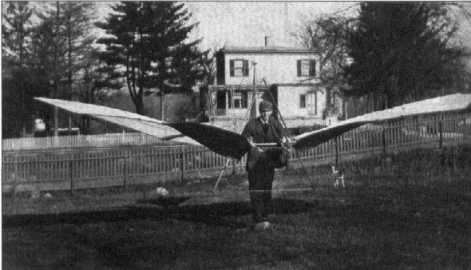
The inventive genius unleashed in the early days of flight
was remarkable, but there was little to distinguish the serious
researcher from the
eccentric. The most serious experimenter in this group of
photographs
was August Herring, whose design was later used by
French-born American experimenter Octave Chanute.
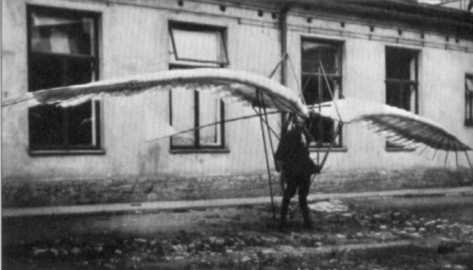
The feathered approach proved
a dead end
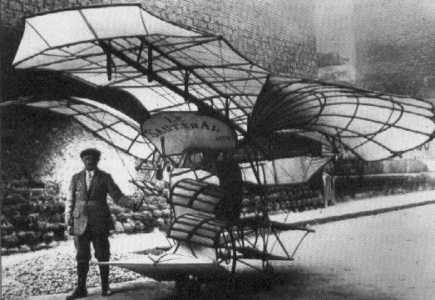
as did Le Sauteral’s 1923
pedal-powered machine (built in 1923)
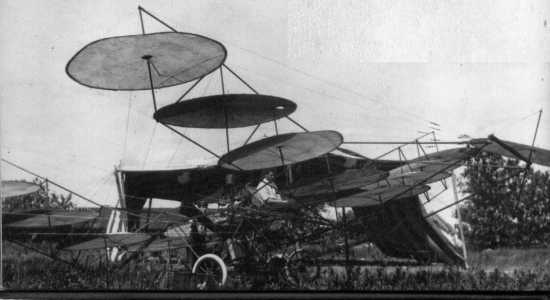
and the 1910 design
(snow), which was based on a
discarded (but theoretically feasible) Cayley idea.
Wenham built a model of a five-wing
aircraft that he did not manage to
fly successfully, but his lecture
brought John Stringfellow out of
retirement to redesign Henson’s
Ariel as a tri-wing
airplane. The plane was part of the
world’s first aviation exhibit at London’s Crystal
Palace in
1868, and this time, the more modest presentation
commanded the public’s respect and
attention (even though none
of the Aerial Steam Carriage’s original problems had been
solved).
In
the coming years, a number of experimenters built
and tested powered aircraft inspired by the
Henson-Stringfellow model or by the designs of Cayley
or Penaud. These aircraft made
short hops and glided for
the most part uncontrolled and un-sustained, but these
were necessary steps on the
way to legitimate flight.
The earliest of the short-hoppers included
Jean-Marie Le Bris, a
French sailor inspired by his observations of
albatrosses at sea. His 1857 glider—which was
pulled by a horse down a
track and then, once aloft, allowed to
glide—looked like a large bird.
On his second glide, Le
Bris crashed and broke his leg. In 1868, another version
of his “artificial bird”
(as he called it) was tested
unmanned.
This time the craft simply crashed and was
destroyed. A more serious effort was made by the French
engineer Felix Du Temple and his brother Louis in 1857. Du
Temple flew a model aircraft of his own design—powered by a
spring-driven clockwork mechanism and with unusual
forward-swept wings (instead of wings that stuck straight
out or were swept back). In 1874, a larger version, powered
by an unknown kind of engine, was flown for a short,
uncontrolled hop by a sailor hired by Du Temple. Similarly,
a steam-powered hop in a piloted aircraft occurred in 1884
in Russia, in a plane built by Alexander F.Mozhaiski after a
design derived directly from Stringfellow’s 1868 effort. Two
other experimenters who made short hops were Clement Ader
and Hiram Maxim.
Ader was a distinguished
French inventor who made important contributions to the
development of the telephone. After some experiments with
tethered gliders, in 1882 he built and tested an ungainly
aircraft, the Eole. On October 9, powered by a steam engine
and weighing a light 653 pounds with pilot, the EoIe lumbered forward and rose about eight inches (20cm) off
the ground for a “flight” of about 165 feet (50m). Ader
seemed to think he had been the first to fly, but those
seriously involved in the field would say only that this had
marked the first take-off of a heavier-than-air craft moving
under its own power, but it was not sustained and controlled
flight.
Ader retracted some of his boastful claims, possibly
so that he could obtain further funding for airplane
development from the French government. His second aircraft,
the Avion III, did not even match the performance of the
Eole, and the French government cut off his funding. Ader
was to become a controversial figure in the history of
flight because of the claims he made in 1904 (belied by his
own notebooks) that his 1890 flight was every bit as
deserving of the accolades then being accorded Santos-Dumont
and the Wrights.
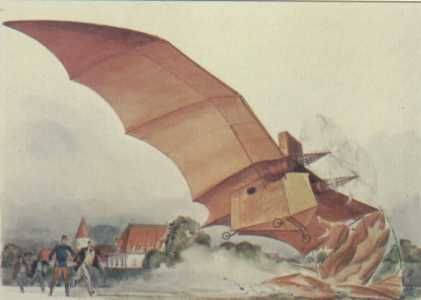
Two machines that might have flown were
Clement Ader’s Avion (LEn’),
grounded when funding was quickly withdrawn after a failed
test in 1897,
Hiram Maxim was born in
Maine in 1840 and became an accomplished draftsman and
machinist. In the late 1870s, he invented the machine
gun and tried to sell it to the U.S. government. The War
Department found his invention impractical and turned him
down, but he found a sympathetic ear at the British War
Office, so he settled in England in 1881. With British
support, he developed a machine gun that could shoot six
hundred rounds per minute, making it a formidable weapon. He
became wealthy from the invention, which allowed him to turn
his attention to a childhood passion—aeronautics.
Maxim was adept at
building lightweight steam engines, including one that
produced 180 horsepower. He constructed a test track that
would allow an aircraft to take off but would then keep it
close to the track. The aircraft he built was huge—two
hundred feet (61m) long with a wingspan of 107 feet (32.5m)
and a wing surface of four hundred square feet (157 sq
m)—and weighed eight thousand pounds (3,632kg); it was
driven by propellers that measured eighteen feet (5.5m) in
diameter. Observers from the British Aeronautical Society
were certain that the craft was capable of flight and had
indeed flown off the track.
More than one observer
urged Maxim to unleash his machine, but Maxim, with an
ebullience some of the British found charming and others
found annoying, insisted that he had paid no attention to
stability and that all he had wanted to demonstrate was that
powered lift was possible with existing engines.
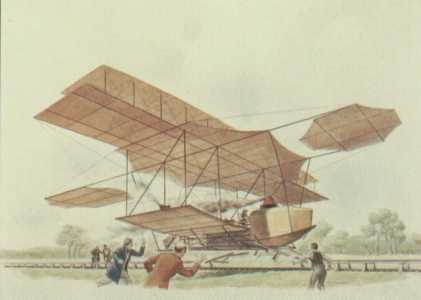
Hiram Maxim’s Giant, which strained against
the rail restraint that kept it from flying.
In this artist’s version, the machine is breaking
through the rail, but is it aloft?
